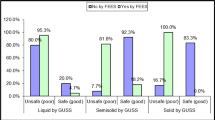Abstract
Swallowing is a complicated, multilevel and neuromuscular physiological function. Transcutaneous neuromuscular electrical stimulation is a relatively new therapeutic intervention for the treatment of swallowing disorders. The aim was to administer and focus on pre and post therapy effects of traditional dysphagia therapy and electrical stimulation (TENS) in 2 participants with posterior stroke. Electrical current along with traditional dysphagia therapy on regular intervals with adequate current levels post stroke. These cumulative therapeutic strategies helped in improving the swallowing mechanism. TENS is one of the new therapeutic technique that has greater advantage along with traditional dysphagia therapy, which promises a lot of scope in cases with acute cerebrovascular accidents.
Similar content being viewed by others
References
Clark H, Lazarus C, Arvedson J, Schooling T, Frymark T (2009) Evidence-based systematic review: effects of neuromuscular electrical stimulation on swallowing and neural activation. Am J Speech Lang Pathol 18:361–375
Restivo DA, Casabona A, Centonze D, Marchese-Ragona R, Maimone D, Pavone A (2013) Pharyngeal electrical stimulation for dysphagia associated with multiple sclerosis: a pilot study. Brain Stimul 6:418–423
Chen YW, Chang KH, Chen HC, Liang WM, Wang YH, Lin YN (2015) The effects of surface neuromuscular electrical stimulation on poststroke dysphagia: a systemic review and meta-analysis. Clin Rehabil 30(1):24–35
Christiaanse ME, Mabe B, Russell G, Simeone TL, Fortunato J, Rubin B (2011) Neuromuscular electrical stimulation is no more effective than usual care for the treatment of primary dysphagia in children. Pediatr Pulmonol 46:559–565
Ashford J, McCabe D, Wheeler-Hegland K, Frymark T, Mullen R, Musson N, Hammond CS (2009) Evidence based systematic review: oropharyngeal dysphagia behavioral treatments. Part III—impact of dysphagia treatments on populations with neurological disorders. J Rehabil Res Dev 46(2):195–204
Huckabee ML, Doeltgen S (2007) Emerging modalities in dysphagia rehabilitation: neuromuscular electrical stimulation. N Z Med J 120:U2744
Pownall S, Enderby P, Sproson L (2017) Electrical stimulation for the treatment of dysphagia. In: Majid A (ed) Electroceuticals. Springer, Cham, pp 137–153. https://doi.org/10.1007/978-3-319-28612-9_6
Freed ML, Freed L, Chatburn RL, Christian M (2001) Electrical stimulation for swallowing disorders caused by stroke. Respir Care 46:466–474
Gallas S, Marie JP, Leroi AM (2010) Sensory transcutaneous electrical stimulation improves post-stroke dysphagic patients. Dysphagia 25(4):291–297
Bogaardt H (2002) Dysfunctie van de bovenste slokdarmsfincter bij slikstoornissen. Logop Fonatrie 3:84–87
Alon G (1991) Principles of electrical stimulation. In: Nelson RM, Currier DP (eds) Clinical electrotherapy, 2nd edn. Appleton & Lange, Norwalk, CT, pp 25–101
Campbell JM (n.d.) General considerations in the clinical application of electrical stimulation. Retrieved from http://www.ifess.org/cedu_generalconsiderations
Carnaby-Mann GD, Crary MA (2007) Examining the evidence on neuromuscular electrical stimulation for swallowing: a meta-analysis. Arch Otolaryngol Head Neck Surg 133(6):564–571
Crary MA, Carnaby-Mann GD, Faunce A (2007) Electrical stimulation therapy for dysphagia: descriptive results of two surveys. Dysphagia 22:165–173
Freed M, Wijting Y (2007) VitalStim therapy: training manual for the use of neuromuscular electrical stimulation in the treatment of dysphagia in the pediatric population. Chattanooga Group, Hixson, TN
Heijnen BJ, Speyer R, Baijens LW, Bogaardt HC (2012) Neuromuscular electrical stimulation versus traditional therapy in patients with Parkinson’s disease and oropharyngeal dysphagia: effects on quality of life. Dysphagia 27:336–345
Babani ND, Hattiangadi GA (2014) Bedside assessment protocol and grading scale for dysphagia in adults: a preliminary study. J Indian Speech Lang Hear Assoc 28(1):10
Huckabee M-L, Doeltgen S (2007) Emerging modalities in dysphagia rehabilitation: neuromuscular electrical stimulation. N Engl Med J 120:1–9
Lee K, Kim S, Lee J, Lee S, Ri J, Park J (2014) The effect of early neuromuscular electrical stimulation therapy in acute/subacute ischemic stroke patients with dysphagia. Ann Rehabil Med 38(2):153–159
Shaw GY, Sechtem PR, Searl J, Keller K, Rawi TA, Dowdy E (2007) Transcutaneous neuromuscular electrical stimulation (VitalStim) curative therapy for severe dysphagia: myth or reality? Ann Otol Rhinol Laryngol 116:36–44
Toyama K, Matsumoto S, Kurasawa M et al (2014) Novel neuromuscular electrical stimulation system for treatment of dysphagia after brain injury. Neurol Med Chir (Tokyo) 54(7):521–528
Park J, Yong S, Kim J, Jung L et al (2014) Cutoff value of pharyngeal residue in prognosis prediction after neuromuscular electrical stimulation therapy for dysphagia in subacute stroke patients. Ann Rehabil Med 38(5):612–619
Thakkar DR, Malarvizhi D (2016) Effectiveness of transcutaneous eletrical neuromuscular stimulation along with exercisces manoeuver in dysphagia: case series. Int J Pharm Bio Sci 7(4):753–756. https://doi.org/10.22376/ijpbs.2016.7.4.b753-756
Author information
Authors and Affiliations
Corresponding author
Additional information
Publisher's Note
Springer Nature remains neutral with regard to jurisdictional claims in published maps and institutional affiliations.
Rights and permissions
About this article
Cite this article
Banik, A.A., Hattiangadi, G.A. Transcutaneous Electrical Neuromuscular Stimulation (TENS) Along with Traditional Dysphagia Therapy in Patients with Posterior Stroke: A Case Study. Indian J Otolaryngol Head Neck Surg 72, 279–283 (2020). https://doi.org/10.1007/s12070-019-01714-x
Received:
Accepted:
Published:
Issue Date:
DOI: https://doi.org/10.1007/s12070-019-01714-x




